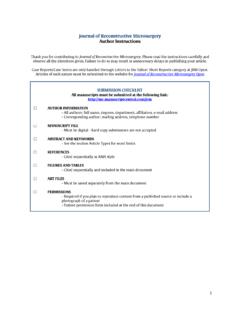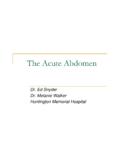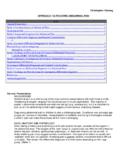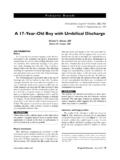Transcription of 1 Right Upper Quadrant Pain - Thieme Medical …
1 Right Upper Quadrant (RUQ) pain is a common complaintthat typically stimulates a workup of the hepatobiliarysystem. In particular, evaluation of the gallbladder (GB) isimportant because cholelithiasis and its complications area frequent cause of RUQ pain . For this reason, tests used inthis condition must be capable of providing accurate infor-mation about the GB. This chapter focuses on the imagingevaluation of the patient with RUQ pain and illustrateswhy the use of ultrasound is so DiagnosisGallstone disease is one of the most common causes ofRUQ pain . Gallstones are present in 10% of the North America, 75% of gallstones are cholesterolstones; the rest are pigment In women, factors thatpredispose to gallstones are increased weight, increasedage, and increased parity. In men, increased age also pre-disposes to gallstones are one of the most commoncauses of RUQ pain , the majority of patients with gall-stones are studies performed forother reasons often discover patients with asymptomatic(silent) gallstones.
2 Silent gallstones tend to become symp-tomatic at a rate of 2% per ,4 The overall risk after 20years is 18%.3 Patients with gallstones are unlikely to de-velop symptoms after 10 to15 years of being asympto-matic. Those patients who ultimately do develop symp-toms almost always have episodes of biliary colic first. It isvery unusual for a patient to develop acute cholecystitis asthe initial symptom of gallstone disease without previousincidents of colic. Based on these statistics and the knownrisk of cholecystectomy, it has been shown that perform-ing prophylactic cholecystectomy in asymptomatic pa-tients actually decreases their overall life expectancy andincreases the cost of these reasons, asymp-tomatic gallstones are generally not treated one third of all patients with gallstoneswill develop symptoms. Patients with symptomatic gall-stone disease generally first seek Medical attention due tobouts of biliary colic.
3 As already mentioned, patients thatfirst present with acute cholecystitis will generally de-scribe previous episodes consistent with biliary colic. Dys-peptic symptoms (pyrosis, flatulence, vague abdominaldiscomfort, and fatty food intolerance) may occur in pa-tients with gallstones but it is hard to prove a cause-and-effect relationship because these symptoms are also verycommon in patients without symptom complex of biliary colic is producedwhen a stone obstructs the cystic duct or GB neck. Classi-cally, these patients experience acute RUQ or epigastricpain that increases in intensity over several seconds orminutes and then persists for several (usually 4 to 6) pain may begin in the RUQ and radiate to the epigas-trium or vice versa. It may occasionally be most severe inthe left Upper Quadrant , precordium, or even the lower ,6 Periodic exacerbations may occur during a givenepisode, but, in general, the pain is fairly steady (colic is amisnomer).
4 In most cases, there is no obvious cause of bil-iary colic. In some patients, the pain is provoked by a to palpation is colic may be relieved if the obstructing stonespontaneously disimpacts from the cystic duct or GB may also be relieved if the stone passes through the cys-tic duct and into the bile duct. If the stone subsequentlyobstructs the common bile duct, a second episode of bil-iary colic may occur. The interval between attacks of bil-iary colic is very unpredictable and can vary from weeks tomonths to cholecystitis develops if there is persistent cysticduct or GB neck obstruction. This diagnosis should be con-sidered when the patient s symptoms persist beyond 6hours. Acute cholecystitis is manifest as persistent RUQpain that may radiate to the Right shoulder, Right scapula,or interscapular area. Nausea, vomiting, chills, fever, andRUQ tenderness and guarding are common. Leukocytosisand elevations of alkaline phosphatase, aminotransferase(transaminase), and amylase may occur.
5 Mild hyperbiliru-binemia is seen in as many as 20% of levelsgreater than 4 mg/100 mL may occur if there is commonbile duct addition to GB disease, many other disease processescan potentially produce RUQ are listed in Table1 particular, liver diseases should be strongly consid-ered, including diffuse hepatic parenchymal diseases suchas hepatitis (viral, alcoholic, drug induced, or toxin in-duced) or passive hepatic congestion, or focal hepatic dis-eases. Focal liver tumors can produce pain due to rapidgrowth, bleeding, or infarction. Hepatic abscesses, perihep-atitis (Fitz-Hugh-Curtis syndrome), hematomas, and hem-orrhagic cysts are also capable of producing RUQ Upper Quadrant PainWilliam Middleton1AQ1ally presents primarily as RUQ pain . Peptic ulcer disease,colitis, ileitis, intestinal obstruction, irritable bowel syn-drome, and intestinal tumors are additional Right kidney is another source of RUQ pain .
6 Renalcolic may present with atypical symptoms and be con-fused with GB disease. Pyelonephritis, renal abscess,hematoma, hemorrhagic cysts, tumors, and ischemia areother renal diseases that can cause RUQ other processes to be considered in pa-tients with RUQ pain are Right -lower-lobe pneumonia andpulmonary infarction, myocardial ischemia, local chestand abdominal wall lesions, local musculoskeletal lesions, Right adrenal lesions, and herpes relative prevalence of the different causes of RUQpain varies from institute to institute. Table 1 2catego-rizes these causes by their approximate EvaluationNonimaging TestsIn many patients with RUQ pain , a careful history and phys-ical examination will help guide the workup in the appro-priate direction. However, the signs and symptoms of themany conditions potentially capable of causing RUQ painoverlap greatly. For this reason, there is a multitude of use-ful diagnostic tests.
7 The most common tests are (1) liverfunction tests (LFTs), (2) amylase levels, (3) urinalysis, (4)white blood cell counts, and (5) electrocardiograms (ECGs).The bile ducts can also be responsible for RUQ pain . Bil-iary colic from an obstructing common bile duct stone isprobably the most frequent cause of bile duct related RUQpain. Cholangitis, choledochal cysts, and tumors are may also cause confusion because it canboth simulate and coexist with GB disease. A transientepisode of biliary colic may be followed by an episode ofpancreatitis as the stone passes through the common ductand obstructs the pancreatic abnormalities should also be consid-ered in the differential diagnosis. Appendicitis occasion-I The Abdomen4 Table 1 1 Differential Diagnosis of Right Upper Quadrant Pain1. Biliary colic2. Acute cholecystitis3. Acute pancreatitis4. Acute appendicitis5. Disorders of the livera. Acute hepatitisi. Alcoholicii. Viraliii.
8 Drug-relatediv. Toxinsb. Hepatic abscessc. Hepatic tumorsi. Metastasesii. Hepatocellular canceriii. Hemangiomaiv. Focal nodular hyperplasiav. Hepatic adenomad. Hemorrhagic cyste. Hepatic congestioni. Budd-Chiari syndromeii. Acute hepatic congestion6. Disorders of the bile ductsa. Bile duct obstructionb. Cholangitis7. Disorders of the intestinesa. Peripyloric ulcers with or without perforationb. Small bowel obstructionc. Irritable boweld. Colitise. Ileitisf. Intestinal tumors8. Costochondritis of the lower Right anterior chest9. Perihepatitis due to gonococcal or chlamydial infection (Fitz-Hugh-Curtis syndrome)10. Pleuroabdominal pain due to pneumonia or pulmonary infarction11. Disorders of the Right kidneya. Acute pyelonephritisb. Ureteral calculusc. Renal or perirenal abscessd. Renal infarctione. Renal tumor12. Unknown causes13. Herpes zosterTable 1 2 Causes of Right Upper Quadrant PainCommonUncommonRareBiliary colicDrug-related and Budd-Chiari toxic hepatitissyndromeCholecystitisHepatic hemangiomaAcute Hepatic abscessHepatic adenomapancreatitisAcute Hepatocellular Focal nodular appendicitiscarcinomahyperplasiaAlcoholi c Ascending hepatitischolangitisViral hepatitis Acute pyelonephritis Pneumonia/pleuritisHepatic Renal tumorRenal abscessmetastasesIrritable bowel Peptic ulcer disease Perinephric abscessCostochondritisRenal infractionUnknown casesPerihepatitis(Fitz-Hugh-Curtissyndr ome)AQ8 LFTs are among the most useful initial laboratory testsbecause certain abnormalities strongly suggest hepatobil-iary disease.
9 In addition, the pattern of abnormality onLFTs can point toward liver parenchymal processes or bil-iary processes. (Please see the chapter on evaluation of ab-normal LFTs .) Renal, pancreatic, and cardiac abnormalitiescan be identified in many cases by obtaining a urinalysis, aserum amylase level, and an Tests other than UltrasoundThe initial imaging tests in patients with RUQ pain shouldbe radiographs of the chest and abdomen. These are rapidand inexpensive ways of evaluating the patient for pul-monary and intestinal sources of pain . In addition, abdom-inal radiographs can detect calcifications in the kidney,ureter, appendix, and pancreas. Gallstones that are suffi-ciently calcified to be radiopaque (10 to 15% of cases) canalso be detected. Rarely, gallstones will contain enough gasto be visible on radiographs. Therefore, although abdomi-nal radiographs may reveal gallstones, a negative studydoes not exclude the the patient presents with suspected biliary colic andthe preliminary tests fail to suggest an alternative sourceof pain , then the GB should be evaluated to determine thepresence or absence of gallstones.
10 In addition to abdomi-nal radiographs, there are several imaging tests that are ca-pable of detecting gallstones. The sensitivity of these vari-ous tests is indicated in Table 1 tomography (CT) is much better at detectingsmall degrees of calcification than plain radiography and istherefore more sensitive at detecting gallstones. CT canalso detect some cholesterol stones that are less densethan surrounding bile as well as stones that contain gas. Inaddition, unlike abdominal radiography, CT can determinethe anatomical location of a calcification and confirm thatit is in the GB. Unfortunately, at least 20% of gallstoneshave the same attenuation as bile and are not detectablewith this reason, CT is useful when positive but notuseful when cholecystography (OCG) was the preferred meansof diagnosing gallstones for many years. When the GB iswell opacified, OCG is similar to sonography in its ability todetect and exclude gallstones.











